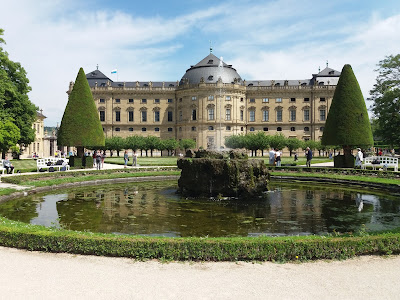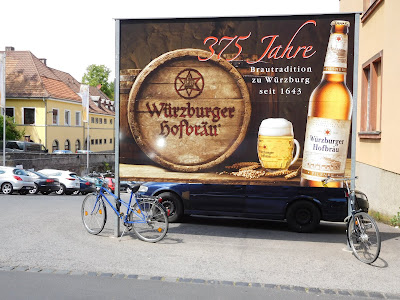Well it’s certainly been the hottest and the driest summer
we’ve had for many a long year, and it looks as though it’s set to continue for
a while yet. It’s also been a rather strange summer; neither here nor there, as
Bill Bryson so eloquently put it.
The strange feeling to the summer began at the beginning of
June, following the sudden and totally unexpected death of our company General
Manager. It’s worrying when someone who’s younger, fitter and considerably
slimmer than yourself collapses suddenly and dies; especially when it was without
any warning.
We’ve been rather in limbo since then, having lost a well-regarded
colleague who was also a generally all-round, good bloke, who cared
passionately about the company and the people who work there. For the moment we
find ourselves somewhat rudderless, with no-one to pilot the ship through
increasingly rocky waters, but the real tragedy is that Barry’s wife and
children have lost a loving husband and father, who was looking forward to
retirement in a few years time.
Still the show must go on, as Freddy Mercury sang, and we’ve
had two senior people over from our parent company in Japan,
not just for moral support, but to make sure the company stays on track. Our
order book is at a record high, which kind of brings its own problems, but these
are nice problems to have, and I’m sure that by pulling together we’ll succeed
in meeting our customers’ expectations.
On the home front, Mrs PBT’s continues to improve and is
busy planning a “stay-cation” for us later in the year. Regular readers will
know that I’m off to America
next month – in fact in just over a fortnight’s time, so I’ve been pretty busy
planning the trip, and booking flights and accommodation.
The fact that I’ll be away for a fortnight, has meant I’m a
little reluctant to eat further into my annual leave entitlement. There’s been
quite a bit occurring on the local beer front recently, culminating in a trip which a number of my friends made on Friday to Canterbury, for the
Kent Beer Festival. I gave this a miss, for the above reason, but there's also not
been time for walking a few more sections of the North Down’s Way. Fortunately the high temperatures have not been conducive
to long-distance walking, so I don’t feel as if I've missed out on too much.
Last weekend saw licensees Fran and Richard, celebrating
their first year at the Greyhound, Charcott; an event they marked with a
mini-beer festival. That unfortunately clashed with a friend’s 80th
Birthday party, which had a theme based on characters from the Beano. Eddie was
born in 1938, which was the year the legendary comic first hit the news-stands,
so all the guests were asked to dress up as characters who have featured in the
comic.
I have to say, there were a few too many Dennis the
Menaces, but Mrs PBT’s went along as
Minnie the Minx and yours truly appeared as Lord Snooty. A good time was had by
all, with copious quantities of drink consumed along with just the right amount of food to soak it all
up.
Last Monday evening, I attended my local CAMRA branch’s
business meeting, which was held at the recently opened Nelson Arms, in
Tonbridge. We had a turn-out of 14, which was something of a record, and whilst
the meeting did drag on a bit, it was good to catch up afterwards with friends
I hadn’t seen for a while.
The beer too was good, with the Young’s London Gold and
Whitstable East India Pale in fine form. A beer which was well worth finishing
up on was “4 Hop Men of the Apocalypse,” a strong and well-hopped IPA from
Totally Brewed.
On Friday a colleague and
I called in for a lunchtime drink at the Greyhound. Having seen some of
the punters enjoying a nice cool, tall and refreshing glass of Hofmeister, I
decided to forgo the cask and grab a glass myself. It was good, and streets
away from the brand with the same name that was flaunted about by Courage, back
in the 80’s, and promoted by a “Jack-the-lad,” bear character, called George.
 “For great lager, follow the bear,” was the slogan at the time, but the
re-launched and totally re-vamped Hofmeister is now a beer worthy of serious
attention. Produced at an un-named brewery in Bavaria,
do give this beer a try if you see it on sale. It is certainly going down a
storm at the Greyhound.
“For great lager, follow the bear,” was the slogan at the time, but the
re-launched and totally re-vamped Hofmeister is now a beer worthy of serious
attention. Produced at an un-named brewery in Bavaria,
do give this beer a try if you see it on sale. It is certainly going down a
storm at the Greyhound.
The pub itself was packed with both drinkers and diners, and
it is so good to see the place thriving under its current owners. It
demonstrates just how important the owners and the people behind the bar are to the success,
or other wise of a pub.
Yesterday evening, my wife and I were guests at yet another
party; a summer one this time. The party took place at the Carpenter’s Arms, Three
Elm Lane, on the outskirts of Tonbridge. It’s an
annual event thrown by the boss of a building
firm who Eileen does work for, as a means of saying thank-you to the
loyal and hard-working employees.
This was the third year running that we’ve been to this
event, and I think it was also one of the best. As is previous years we sat out
on the patio, at the front of the pub enjoying some excellent buffet finger
food - runny Scotch Eggs, miniature beef burgers, home-made sausage rolls and a
rather nice asparagus quiche. There was an open bar, and this time people were
far more sensible, and in the main didn’t take advantage. Certainly there were
far fewer virtually full pints, or barely tasted glasses of wine left abandoned
on the tables at the end of the evening.
The beer selection was also good, with some excellent pints
of Dark Star Hophead (3.0 NBS) and Harvey’s
Sussex (4.0
NBSS). The Carpenters was tastefully renovated in a contemporary style, several
years ago, and is now a popular destination for Tonbridge people wanting a
touch of the rural life, without having to drive too far from the town centre.
(There is even a bus service which operates during the day).
So the “dog days” continue on towards August, with no sign
of a break in the hot weather and no sign of sense prevailing in UK
politics either. The strangeness and the uncertainty from the "increasingly rocky
waters", I referred to earlier, look set to continue for quite
a while yet!













































